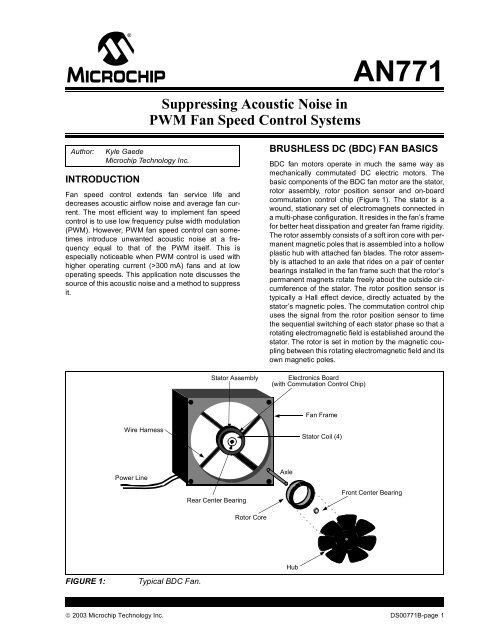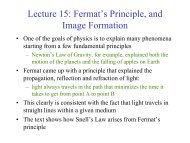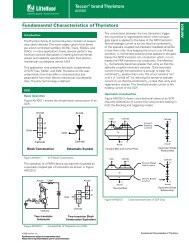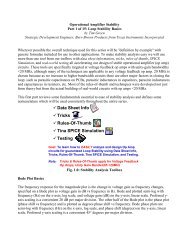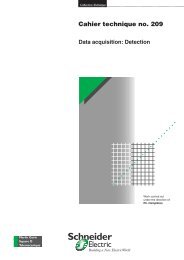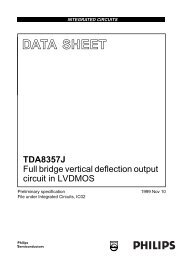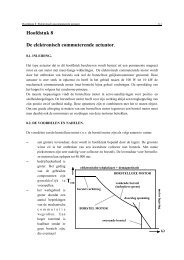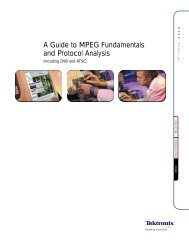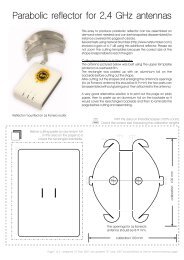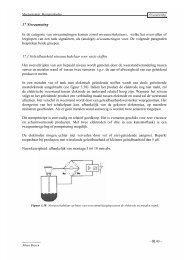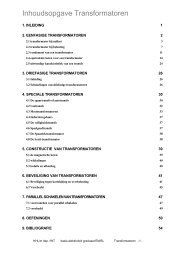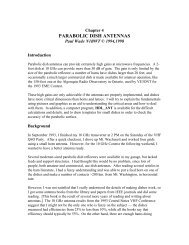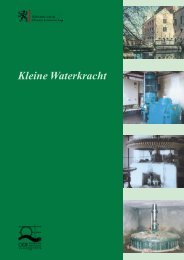Suppressing Acoustic Noise in PWM Fan Speed Control ... - Microchip
Suppressing Acoustic Noise in PWM Fan Speed Control ... - Microchip
Suppressing Acoustic Noise in PWM Fan Speed Control ... - Microchip
Create successful ePaper yourself
Turn your PDF publications into a flip-book with our unique Google optimized e-Paper software.
M AN771<br />
Author: Kyle Gaede<br />
<strong>Microchip</strong> Technology Inc.<br />
INTRODUCTION<br />
<strong>Fan</strong> speed control extends fan service life and<br />
decreases acoustic airflow noise and average fan current.<br />
The most efficient way to implement fan speed<br />
control is to use low frequency pulse width modulation<br />
(<strong>PWM</strong>). However, <strong>PWM</strong> fan speed control can sometimes<br />
<strong>in</strong>troduce unwanted acoustic noise at a frequency<br />
equal to that of the <strong>PWM</strong> itself. This is<br />
especially noticeable when <strong>PWM</strong> control is used with<br />
higher operat<strong>in</strong>g current (>300 mA) fans and at low<br />
operat<strong>in</strong>g speeds. This application note discusses the<br />
source of this acoustic noise and a method to suppress<br />
it.<br />
Wire Harness<br />
Power L<strong>in</strong>e<br />
FIGURE 1: Typical BDC <strong>Fan</strong>.<br />
<strong>Suppress<strong>in</strong>g</strong> <strong>Acoustic</strong> <strong>Noise</strong> <strong>in</strong><br />
<strong>PWM</strong> <strong>Fan</strong> <strong>Speed</strong> <strong>Control</strong> Systems<br />
BRUSHLESS DC (BDC) FAN BASICS<br />
BDC fan motors operate <strong>in</strong> much the same way as<br />
mechanically commutated DC electric motors. The<br />
basic components of the BDC fan motor are the stator,<br />
rotor assembly, rotor position sensor and on-board<br />
commutation control chip (Figure 1). The stator is a<br />
wound, stationary set of electromagnets connected <strong>in</strong><br />
a multi-phase configuration. It resides <strong>in</strong> the fan’s frame<br />
for better heat dissipation and greater fan frame rigidity.<br />
The rotor assembly consists of a soft iron core with permanent<br />
magnetic poles that is assembled <strong>in</strong>to a hollow<br />
plastic hub with attached fan blades. The rotor assembly<br />
is attached to an axle that rides on a pair of center<br />
bear<strong>in</strong>gs <strong>in</strong>stalled <strong>in</strong> the fan frame such that the rotor’s<br />
permanent magnets rotate freely about the outside circumference<br />
of the stator. The rotor position sensor is<br />
typically a Hall effect device, directly actuated by the<br />
stator’s magnetic poles. The commutation control chip<br />
uses the signal from the rotor position sensor to time<br />
the sequential switch<strong>in</strong>g of each stator phase so that a<br />
rotat<strong>in</strong>g electromagnetic field is established around the<br />
stator. The rotor is set <strong>in</strong> motion by the magnetic coupl<strong>in</strong>g<br />
between this rotat<strong>in</strong>g electromagnetic field and its<br />
own magnetic poles.<br />
Stator Assembly Electronics Board<br />
(with Commutation <strong>Control</strong> Chip)<br />
Rear Center Bear<strong>in</strong>g<br />
Rotor Core<br />
<strong>Fan</strong> Frame<br />
Stator Coil (4)<br />
Front Center Bear<strong>in</strong>g<br />
© 2003 <strong>Microchip</strong> Technology Inc. DS00771B-page 1<br />
Axle<br />
Hub
AN771<br />
ACOUSTIC NOISE SOURCES<br />
The most dom<strong>in</strong>ant source of acoustic fan noise is turbulent<br />
airflow, which is caused by fan operation at full<br />
speed. Employ<strong>in</strong>g fan speed control (where the fan is<br />
operated primarily at lower than full speed) m<strong>in</strong>imizes<br />
this noise. The second most dom<strong>in</strong>ant acoustic noise is<br />
due to BDC fan’s torque characteristic. As shown <strong>in</strong><br />
Figure 2 and Figure 3, stator excitation is a square<br />
wave that is switched “on” 45° before peak torque position<br />
and switched “off ” 45° after peak torque position.<br />
This excitation causes a small amount of ripple <strong>in</strong> motor<br />
torque at the frequency of commutation. Each small<br />
torque “burst” causes a m<strong>in</strong>ute flex<strong>in</strong>g of the entire fan<br />
structure and results <strong>in</strong> a fa<strong>in</strong>t (but audible) “tick<strong>in</strong>g”<br />
noise while the BDC fan is operat<strong>in</strong>g (Figure 2).<br />
<strong>Acoustic</strong> <strong>PWM</strong> noise is generated <strong>in</strong> exactly the same<br />
way. When the <strong>PWM</strong> pulse turns on, a step change <strong>in</strong><br />
torque occurs with<strong>in</strong> the fan, the profile of which<br />
matches the rise time of the <strong>PWM</strong> pulse (Figure 3).<br />
This impulse torque is articulated by the fan structure<br />
as audible noise. This is true mostly <strong>in</strong> larger fans (i.e.,<br />
fans with operat<strong>in</strong>g currents <strong>in</strong> excess of 300 mA),<br />
s<strong>in</strong>ce they generate a greater amount of torque and<br />
have larger size and mass. This effect is also more pronounced<br />
at low operat<strong>in</strong>g speeds (i.e., low <strong>PWM</strong> duty<br />
cycle): the lower the <strong>PWM</strong> duty cycle, the greater the<br />
percentage of time the fan is “off” (quiet) and the more<br />
noticeable the acoustic noise caused by the <strong>PWM</strong><br />
becomes.<br />
Commutated<br />
Torque<br />
Torque<br />
Peak Torque Po<strong>in</strong>ts<br />
45 90 135 180 225 270 315 360<br />
Electrical Degrees<br />
Commutation Po<strong>in</strong>t<br />
FIGURE 2: BDC <strong>Fan</strong> Torque<br />
Characteristics (<strong>Fan</strong> Runn<strong>in</strong>g Cont<strong>in</strong>uously).<br />
<strong>PWM</strong> OFF <strong>PWM</strong> ON<br />
x x + 90<br />
Electrical Degrees<br />
Commutation Po<strong>in</strong>t<br />
FIGURE 3: BDC <strong>Fan</strong> Torque<br />
Characteristics (<strong>PWM</strong> <strong>Control</strong>).<br />
SUPPRESSING <strong>PWM</strong> NOISE<br />
As previously expla<strong>in</strong>ed, <strong>PWM</strong> acoustic noise is caused<br />
by the impulse torque generated by the fan motor dur<strong>in</strong>g<br />
each active <strong>PWM</strong> cycle. Reduc<strong>in</strong>g this acoustic noise<br />
<strong>in</strong>volves slow<strong>in</strong>g the slew rate of the <strong>PWM</strong> switch<strong>in</strong>g,<br />
thereby “smooth<strong>in</strong>g” the <strong>PWM</strong> impulse torque profile.<br />
The circuit <strong>in</strong> Figure 3 depicts any <strong>PWM</strong> fan controller<br />
(such as <strong>Microchip</strong>’s TC646) driv<strong>in</strong>g a low-side switch<strong>in</strong>g<br />
transistor. The added small base capacitor reduces<br />
the slew rate of the driv<strong>in</strong>g waveform (and, therefore,<br />
the slew rate of the output switch<strong>in</strong>g). The value of the<br />
capacitor must be determ<strong>in</strong>ed experimentally, s<strong>in</strong>ce it is<br />
a function of the fan mount<strong>in</strong>g, supply voltage, operat<strong>in</strong>g<br />
current and torque characteristics. In general, the RC<br />
product of the base drive resistor and capacitor should<br />
be 1.0 ms to 4.7 ms for a base drive resistor <strong>in</strong> the range<br />
of 1 kΩ to 10 kΩ.<br />
FIGURE 4: <strong>PWM</strong> <strong>Acoustic</strong> <strong>Noise</strong><br />
Suppression Technique.<br />
DS00771B-page 2 © 2003 <strong>Microchip</strong> Technology Inc.<br />
Torque<br />
V DD<br />
VDD RBASE (1 kΩ to 10 kΩ)<br />
OUT<br />
<strong>PWM</strong><br />
<strong>Fan</strong><br />
<strong>Speed</strong><br />
<strong>Control</strong>ler Slow-Down<br />
GND<br />
Capacitor<br />
(0.40 µF to 1.0 µF)<br />
<strong>PWM</strong><br />
OFF<br />
V FAN<br />
Electrical Degrees<br />
<strong>Fan</strong><br />
Without<br />
Slow-Down Cap With<br />
Slow-Down Cap<br />
<strong>PWM</strong> ON
DRIVING INDUCTIVE LOADS<br />
Inductive kick is another problem that can arise <strong>in</strong> fans<br />
with larger drive currents. As stated earlier, the stator<br />
motor is made up of electromagnetic coils. Because all<br />
<strong>in</strong>ductors have the property V = L(di/dt), the <strong>in</strong>ductor<br />
current cannot go to zero <strong>in</strong>stantaneously. The motor<br />
coil, which happens to be energized at the time the<br />
switch opens, reverses polarity <strong>in</strong> an attempt to ma<strong>in</strong>ta<strong>in</strong><br />
constant current. The voltage on the ground term<strong>in</strong>al<br />
of the fan can <strong>in</strong>crease to 70V or more. This high<br />
voltage can result <strong>in</strong> damage to the drive transistor. The<br />
slow down capacitor prevents this because the transistor<br />
is not turned off <strong>in</strong>stantaneously. The slower transition<br />
time gives the <strong>in</strong>ductor current time to ramp down<br />
before turnoff (see scope plots <strong>in</strong> Figure 5, Figure 6<br />
and Figure 7).<br />
In Figure 5, trace 1 shows the fan’s ground wire voltage,<br />
while trace 2 shows the base of the switch<strong>in</strong>g transistor.<br />
Figure 6 shows the same traces on a different<br />
time scale. Figure 7 shows the same fan with the addition<br />
of the slow down cap. The large voltage spike is<br />
gone and the acoustic noise is reduced dramatically.<br />
These plots were taken us<strong>in</strong>g the TC646EV and a<br />
400 mA fan.<br />
FIGURE 5: Inductive kick voltage spike.<br />
No slow down capacitor, 20 µs time scale.<br />
AN771<br />
FIGURE 6: Inductive kick voltage spike.<br />
No slow down capacitor, 5 ms time scale.<br />
FIGURE 7: Us<strong>in</strong>g a 10 µF slow down<br />
capacitor with 1.1 kΩ base resistor. Notice the<br />
lack of voltage spike and more rounded edges of<br />
Trace 1.<br />
SUMMARY<br />
<strong>PWM</strong> noise, as well as <strong>in</strong>ductive kick, can be reduced<br />
or elim<strong>in</strong>ated by slow<strong>in</strong>g the slew rate of the <strong>PWM</strong><br />
drive signal to the fan. Even a small reduction <strong>in</strong> slew<br />
rate results <strong>in</strong> a significant reduction of the <strong>PWM</strong><br />
noise. The noise-suppression circuit implementation is<br />
simple, requir<strong>in</strong>g only the addition of a small capacitor<br />
to the base of the <strong>PWM</strong> switch<strong>in</strong>g transistor. For very<br />
large fans (more than 500 mA operat<strong>in</strong>g current), DC<br />
speed control may be required (refer to AN770, “L<strong>in</strong>ear<br />
Voltage <strong>Fan</strong> <strong>Speed</strong> <strong>Control</strong> Us<strong>in</strong>g <strong>Microchip</strong>’s TC64X<br />
Family” (DS00770), for implement<strong>in</strong>g such a circuit).<br />
© 2003 <strong>Microchip</strong> Technology Inc. DS00771B-page 3
AN771<br />
NOTES:<br />
DS00771B-page 4 © 2003 <strong>Microchip</strong> Technology Inc.
Note the follow<strong>in</strong>g details of the code protection feature on <strong>Microchip</strong> devices:<br />
• <strong>Microchip</strong> products meet the specification conta<strong>in</strong>ed <strong>in</strong> their particular <strong>Microchip</strong> Data Sheet.<br />
• <strong>Microchip</strong> believes that its family of products is one of the most secure families of its k<strong>in</strong>d on the market today, when used <strong>in</strong> the<br />
<strong>in</strong>tended manner and under normal conditions.<br />
• There are dishonest and possibly illegal methods used to breach the code protection feature. All of these methods, to our<br />
knowledge, require us<strong>in</strong>g the <strong>Microchip</strong> products <strong>in</strong> a manner outside the operat<strong>in</strong>g specifications conta<strong>in</strong>ed <strong>in</strong> <strong>Microchip</strong>'s Data<br />
Sheets. Most likely, the person do<strong>in</strong>g so is engaged <strong>in</strong> theft of <strong>in</strong>tellectual property.<br />
• <strong>Microchip</strong> is will<strong>in</strong>g to work with the customer who is concerned about the <strong>in</strong>tegrity of their code.<br />
• Neither <strong>Microchip</strong> nor any other semiconductor manufacturer can guarantee the security of their code. Code protection does not<br />
mean that we are guarantee<strong>in</strong>g the product as “unbreakable.”<br />
Code protection is constantly evolv<strong>in</strong>g. We at <strong>Microchip</strong> are committed to cont<strong>in</strong>uously improv<strong>in</strong>g the code protection features of our<br />
products. Attempts to break microchip’s code protection feature may be a violation of the Digital Millennium Copyright Act. If such<br />
acts allow unauthorized access to your software or other copyrighted work, you may have a right to sue for relief under that Act.<br />
Information conta<strong>in</strong>ed <strong>in</strong> this publication regard<strong>in</strong>g device<br />
applications and the like is <strong>in</strong>tended through suggestion only<br />
and may be superseded by updates. It is your responsibility to<br />
ensure that your application meets with your specifications. No<br />
representation or warranty is given and no liability is assumed<br />
by <strong>Microchip</strong> Technology Incorporated with respect to the<br />
accuracy or use of such <strong>in</strong>formation, or <strong>in</strong>fr<strong>in</strong>gement of patents<br />
or other <strong>in</strong>tellectual property rights aris<strong>in</strong>g from such use or<br />
otherwise. Use of <strong>Microchip</strong>’s products as critical components <strong>in</strong><br />
life support systems is not authorized except with express<br />
written approval by <strong>Microchip</strong>. No licenses are conveyed,<br />
implicitly or otherwise, under any <strong>in</strong>tellectual property rights.<br />
Trademarks<br />
The <strong>Microchip</strong> name and logo, the <strong>Microchip</strong> logo, KEELOQ,<br />
MPLAB, PIC, PICmicro, PICSTART, PRO MATE and<br />
PowerSmart are registered trademarks of <strong>Microchip</strong> Technology<br />
Incorporated <strong>in</strong> the U.S.A. and other countries.<br />
FilterLab, microID, MXDEV, MXLAB, PICMASTER, SEEVAL<br />
and The Embedded <strong>Control</strong> Solutions Company are registered<br />
trademarks of <strong>Microchip</strong> Technology Incorporated <strong>in</strong> the U.S.A.<br />
Accuron, dsPIC, dsPICDEM.net, ECONOMONITOR,<br />
<strong>Fan</strong>Sense, FlexROM, fuzzyLAB, In-Circuit Serial Programm<strong>in</strong>g,<br />
ICSP, ICEPIC, microPort, Migratable Memory, MPASM, MPLIB,<br />
MPLINK, MPSIM, PICC, PICkit, PICDEM, PICDEM.net,<br />
PowerCal, PowerInfo, PowerTool, rfPIC, Select Mode,<br />
SmartSensor, SmartShunt, SmartTel and Total Endurance are<br />
trademarks of <strong>Microchip</strong> Technology Incorporated <strong>in</strong> the U.S.A.<br />
and other countries.<br />
Serialized Quick Turn Programm<strong>in</strong>g (SQTP) is a service mark of<br />
<strong>Microchip</strong> Technology Incorporated <strong>in</strong> the U.S.A.<br />
All other trademarks mentioned here<strong>in</strong> are property of their<br />
respective companies.<br />
© 2003, <strong>Microchip</strong> Technology Incorporated, Pr<strong>in</strong>ted <strong>in</strong> the<br />
U.S.A., All Rights Reserved.<br />
Pr<strong>in</strong>ted on recycled paper.<br />
<strong>Microchip</strong> received QS-9000 quality system<br />
certification for its worldwide headquarters,<br />
design and wafer fabrication facilities <strong>in</strong><br />
Chandler and Tempe, Arizona <strong>in</strong> July 1999<br />
and Mounta<strong>in</strong> View, California <strong>in</strong> March 2002.<br />
The Company’s quality system processes and<br />
procedures are QS-9000 compliant for its<br />
PICmicro ® 8-bit MCUs, KEELOQ ® code hopp<strong>in</strong>g<br />
devices, Serial EEPROMs, microperipherals,<br />
non-volatile memory and analog products. In<br />
addition, <strong>Microchip</strong>’s quality system for the<br />
design and manufacture of development<br />
systems is ISO 9001 certified.<br />
© 2003 <strong>Microchip</strong> Technology Inc. DS00771B - page 5
M<br />
AMERICAS<br />
Corporate Office<br />
2355 West Chandler Blvd.<br />
Chandler, AZ 85224-6199<br />
Tel: 480-792-7200 Fax: 480-792-7277<br />
Technical Support: 480-792-7627<br />
Web Address: http://www.microchip.com<br />
Rocky Mounta<strong>in</strong><br />
2355 West Chandler Blvd.<br />
Chandler, AZ 85224-6199<br />
Tel: 480-792-7966 Fax: 480-792-4338<br />
Atlanta<br />
3780 Mansell Road, Suite 130<br />
Alpharetta, GA 30022<br />
Tel: 770-640-0034 Fax: 770-640-0307<br />
Boston<br />
2 Lan Drive, Suite 120<br />
Westford, MA 01886<br />
Tel: 978-692-3848 Fax: 978-692-3821<br />
Chicago<br />
333 Pierce Road, Suite 180<br />
Itasca, IL 60143<br />
Tel: 630-285-0071 Fax: 630-285-0075<br />
Dallas<br />
4570 Westgrove Drive, Suite 160<br />
Addison, TX 75001<br />
Tel: 972-818-7423 Fax: 972-818-2924<br />
Detroit<br />
Tri-Atria Office Build<strong>in</strong>g<br />
32255 Northwestern Highway, Suite 190<br />
Farm<strong>in</strong>gton Hills, MI 48334<br />
Tel: 248-538-2250 Fax: 248-538-2260<br />
Kokomo<br />
2767 S. Albright Road<br />
Kokomo, Indiana 46902<br />
Tel: 765-864-8360 Fax: 765-864-8387<br />
Los Angeles<br />
18201 Von Karman, Suite 1090<br />
Irv<strong>in</strong>e, CA 92612<br />
Tel: 949-263-1888 Fax: 949-263-1338<br />
San Jose<br />
<strong>Microchip</strong> Technology Inc.<br />
2107 North First Street, Suite 590<br />
San Jose, CA 95131<br />
Tel: 408-436-7950 Fax: 408-436-7955<br />
Toronto<br />
6285 Northam Drive, Suite 108<br />
Mississauga, Ontario L4V 1X5, Canada<br />
Tel: 905-673-0699 Fax: 905-673-6509<br />
WORLDWIDE SALES AND SERVICE<br />
ASIA/PACIFIC<br />
Australia<br />
<strong>Microchip</strong> Technology Australia Pty Ltd<br />
Suite 22, 41 Rawson Street<br />
Epp<strong>in</strong>g 2121, NSW<br />
Australia<br />
Tel: 61-2-9868-6733 Fax: 61-2-9868-6755<br />
Ch<strong>in</strong>a - Beij<strong>in</strong>g<br />
<strong>Microchip</strong> Technology Consult<strong>in</strong>g (Shanghai)<br />
Co., Ltd., Beij<strong>in</strong>g Liaison Office<br />
Unit 915<br />
Bei Hai Wan Tai Bldg.<br />
No. 6 Chaoyangmen Beidajie<br />
Beij<strong>in</strong>g, 100027, No. Ch<strong>in</strong>a<br />
Tel: 86-10-85282100 Fax: 86-10-85282104<br />
Ch<strong>in</strong>a - Chengdu<br />
<strong>Microchip</strong> Technology Consult<strong>in</strong>g (Shanghai)<br />
Co., Ltd., Chengdu Liaison Office<br />
Rm. 2401-2402, 24th Floor,<br />
M<strong>in</strong>g X<strong>in</strong>g F<strong>in</strong>ancial Tower<br />
No. 88 TIDU Street<br />
Chengdu 610016, Ch<strong>in</strong>a<br />
Tel: 86-28-86766200 Fax: 86-28-86766599<br />
Ch<strong>in</strong>a - Fuzhou<br />
<strong>Microchip</strong> Technology Consult<strong>in</strong>g (Shanghai)<br />
Co., Ltd., Fuzhou Liaison Office<br />
Unit 28F, World Trade Plaza<br />
No. 71 Wusi Road<br />
Fuzhou 350001, Ch<strong>in</strong>a<br />
Tel: 86-591-7503506 Fax: 86-591-7503521<br />
Ch<strong>in</strong>a - Hong Kong SAR<br />
<strong>Microchip</strong> Technology Hongkong Ltd.<br />
Unit 901-6, Tower 2, Metroplaza<br />
223 H<strong>in</strong>g Fong Road<br />
Kwai Fong, N.T., Hong Kong<br />
Tel: 852-2401-1200 Fax: 852-2401-3431<br />
Ch<strong>in</strong>a - Shanghai<br />
<strong>Microchip</strong> Technology Consult<strong>in</strong>g (Shanghai)<br />
Co., Ltd.<br />
Room 701, Bldg. B<br />
Far East International Plaza<br />
No. 317 Xian Xia Road<br />
Shanghai, 200051<br />
Tel: 86-21-6275-5700 Fax: 86-21-6275-5060<br />
Ch<strong>in</strong>a - Shenzhen<br />
<strong>Microchip</strong> Technology Consult<strong>in</strong>g (Shanghai)<br />
Co., Ltd., Shenzhen Liaison Office<br />
Rm. 1812, 18/F, Build<strong>in</strong>g A, United Plaza<br />
No. 5022 B<strong>in</strong>he Road, Futian District<br />
Shenzhen 518033, Ch<strong>in</strong>a<br />
Tel: 86-755-82901380 Fax: 86-755-82966626<br />
Ch<strong>in</strong>a - Q<strong>in</strong>gdao<br />
Rm. B503, Fullhope Plaza,<br />
No. 12 Hong Kong Central Rd.<br />
Q<strong>in</strong>gdao 266071, Ch<strong>in</strong>a<br />
Tel: 86-532-5027355 Fax: 86-532-5027205<br />
India<br />
<strong>Microchip</strong> Technology Inc.<br />
India Liaison Office<br />
Divyasree Chambers<br />
1 Floor, W<strong>in</strong>g A (A3/A4)<br />
No. 11, O’Shaugnessey Road<br />
Bangalore, 560 025, India<br />
Tel: 91-80-2290061 Fax: 91-80-2290062<br />
Japan<br />
<strong>Microchip</strong> Technology Japan K.K.<br />
Benex S-1 6F<br />
3-18-20, Sh<strong>in</strong>yokohama<br />
Kohoku-Ku, Yokohama-shi<br />
Kanagawa, 222-0033, Japan<br />
Tel: 81-45-471- 6166 Fax: 81-45-471-6122<br />
Korea<br />
<strong>Microchip</strong> Technology Korea<br />
168-1, Youngbo Bldg. 3 Floor<br />
Samsung-Dong, Kangnam-Ku<br />
Seoul, Korea 135-882<br />
Tel: 82-2-554-7200 Fax: 82-2-558-5934<br />
S<strong>in</strong>gapore<br />
<strong>Microchip</strong> Technology S<strong>in</strong>gapore Pte Ltd.<br />
200 Middle Road<br />
#07-02 Prime Centre<br />
S<strong>in</strong>gapore, 188980<br />
Tel: 65-6334-8870 Fax: 65-6334-8850<br />
Taiwan<br />
<strong>Microchip</strong> Technology (Barbados) Inc.,<br />
Taiwan Branch<br />
11F-3, No. 207<br />
Tung Hua North Road<br />
Taipei, 105, Taiwan<br />
Tel: 886-2-2717-7175 Fax: 886-2-2545-0139<br />
EUROPE<br />
Austria<br />
<strong>Microchip</strong> Technology Austria GmbH<br />
Durisolstrasse 2<br />
A-4600 Wels<br />
Austria<br />
Tel: 43-7242-2244-399<br />
Fax: 43-7242-2244-393<br />
Denmark<br />
<strong>Microchip</strong> Technology Nordic ApS<br />
Regus Bus<strong>in</strong>ess Centre<br />
Lautrup hoj 1-3<br />
Ballerup DK-2750 Denmark<br />
Tel: 45 4420 9895 Fax: 45 4420 9910<br />
France<br />
<strong>Microchip</strong> Technology SARL<br />
Parc d’Activite du Moul<strong>in</strong> de Massy<br />
43 Rue du Saule Trapu<br />
Batiment A - ler Etage<br />
91300 Massy, France<br />
Tel: 33-1-69-53-63-20 Fax: 33-1-69-30-90-79<br />
Germany<br />
<strong>Microchip</strong> Technology GmbH<br />
Ste<strong>in</strong>heilstrasse 10<br />
D-85737 Isman<strong>in</strong>g, Germany<br />
Tel: 49-89-627-144 0 Fax: 49-89-627-144-44<br />
Italy<br />
<strong>Microchip</strong> Technology SRL<br />
Centro Direzionale Colleoni<br />
Palazzo Taurus 1 V. Le Colleoni 1<br />
20041 Agrate Brianza<br />
Milan, Italy<br />
Tel: 39-039-65791-1 Fax: 39-039-6899883<br />
United K<strong>in</strong>gdom<br />
<strong>Microchip</strong> Ltd.<br />
505 Eskdale Road<br />
W<strong>in</strong>nersh Triangle<br />
Wok<strong>in</strong>gham<br />
Berkshire, England RG41 5TU<br />
Tel: 44 118 921 5869 Fax: 44-118 921-5820<br />
DS00771B-page 6 © 2003 <strong>Microchip</strong> Technology Inc.<br />
12/05/02


